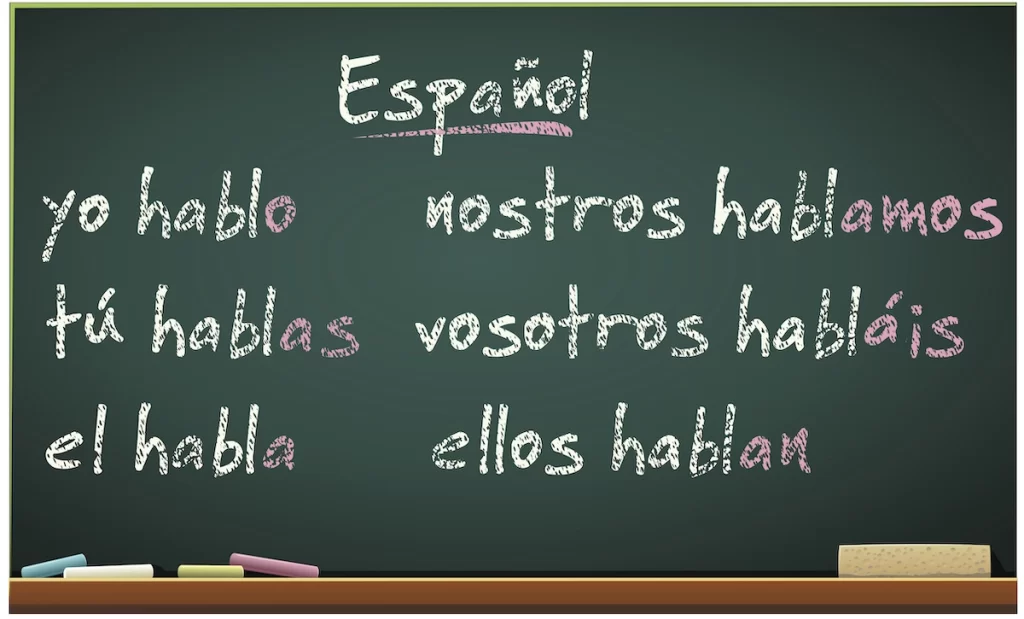How to Manage the Most Frequently Used Verb Conjugations in Spanish for Healthcare Workers.
Verbs are are the glue that hold a language together and create meaning. A pure vocabulary-based subject/noun/adjective communication style is caveman speak, and you’re way too smart for that!
So, in this post we’re breaking down the 6 most common Spanish verb conjugations and verb tenses for everyday clinical settings. Of course there are more verb tenses in the Spanish language, but since your goal is not to be a Spanish linguist – you should probably focus on these first. Take a look below!
Get the full lesson notes here:
Spanish Verb Tense #1 – Present Tense:
Meaning: to describe everyday things that you are doing or do habitually.
Conjugations: stem of the verb + the conjugations below
| AR Verbs | ER Verbs | IR Verbs | |||
| Yo: -o | Nosotros -amos | Yo -o | Nosotros -emos | Yo -o | Nosotros -imos |
| Tú: -as | Tú -es | Tú -es | |||
| Él, Ella, -a Usted | Ellos, Ellas, -an Ustedes | Él, Ella, -e Usted | Ellos, Ellas, -en Ustedes | Él, Ella, -e Usted | Ellos, Ellas, -en Ustedes |
Common Irregular verbs in the present tense:
[grid]
[row]
[column five wide]Caerse = to fall down
Conocer = to know (people or places)
Dar = to give
Decir = to say / to tell
Estar = to be (feelings, location, state of being)
Hacer = to do[/column] [column five wide]
Ir = to go
Oir = to hear
Poner = to put / to place
Saber = to know (information, facts, how to do something)
Salir = to go out[/column] [column five wide]
Ser = to be (occupation, characteristics, origin/nationality, time)
Tener = to have
Traer = to bring
Venir = to come
Ver = to see [/column][/row][/grid]
Spanish Verb Tense #2 – Preterite Past Tense (simple past):
Meaning: this is the simple past tense used to describe completed actions in the past.
Uses: SPICY & SAFE Acronyms for Preterite Past tense
| AR Verbs | ER Verbs | IR Verbs | |||
| Yo: -é | Nosotros -amos | Yo -í | Nosotros -imos | Yo -í | Nosotros -imos |
| Tú: -aste | Tú -iste | Tú -iste | |||
| Él, Ella, -ó Usted | Ellos, Ellas, -aron Ustedes | Él, Ella, -ió Usted | Ellos, Ellas, -ieron Ustedes | Él, Ella, -ió Usted | Ellos, Ellas, -ieron Ustedes |
Irregular Preterite Past Tense Verbs in Spanish:
[grid]
[row]
[column five wide]Andar = to walk
Dar = to give
Decir = to say / to tell
Estar = to be (feelings, location, state of being)
Hacer = to do / to make[/column][column five wide]
Ir = to go
Poder = to be able to
Poner = to put / to place
Querer = to want / to desire
Saber = to know (means “found out” in this tense)[/column][column five wide]
Ser = to be (occupation, characteristics, origin/nationality, time)
Tener = to have
Traer = to bring
Venir = to come[/column][/row][/grid]
Spanish Verb Tense #3 – Imperfect Past Tense (continuous past):
Meaning: This is the past tense that often describes habitual actions in the past “used to” or an ongoing action in the past “was doing”.
Uses: See DUWIT Acronym here
| AR Verbs | ER Verbs | IR Verbs | |||
| Yo: -aba | Nosotros -ábamos | Yo -ía | Nosotros -íamos | Yo -ía | Nosotros -íamos |
| Tú: -abas | Tú -ías | Tú -ías | |||
| Él, Ella, -aba Usted | Ellos, Ellas, -aban Ustedes | Él, Ella, -ía Usted | Ellos, Ellas, -ían Ustedes | Él, Ella, -ía Usted | Ellos, Ellas, -ían Ustedes |
Irregular Imperfect Past Tense Verbs in Spanish:
Ir = to go
Ser = to be (occupation, characteristics, origin/nationality, time)
Ver = to see
Spanish Verb Tense #4 – Present Perfect Tense:
Meaning: to “have done” something
Conjugation: Helping verb “haber” + the stem of the verb (everything but the ending) plus the conjugations below
| AR Verbs | ER Verbs | IR Verbs | |||
| Yo: he + -ado | Nos. hemos + -ado | Yo he + -ido | Nos. hemos + -ido | Yo he + -ido | Nos. hemos + -ido |
| Tú: has + -ado | Tú has + -ido | Tú has + -ido | |||
| Él Ella ha + -ado Usted | Ellos Ellas han + -ado Ustedes | Él Ella ha + -ido Usted | Ellos Ellas han + -ido Ustedes | Él Ella ha + -ido Usted | Ellos Ellas han + -ido Ustedes |
Common Irregular Verbs in the Present Perfect Tense (same irregulars for Past Perfect Tense):
[grid]
[row]
[column five wide]Abrir = to open
Cubrir = to cover
Decir = to say / to tell
Escribir = to write[/column][column five wide]
Hacer = to do / to make
Morir = to die
Poner = to put / to place
Resolver = to resolve[/column][column five wide]
Romper = to break
Volver = to return
Ver = to see[/column][/row][/grid]
Spanish Verb Tense #5a – Imperative (Command) Tense for Usted:
Meaning: this is the command tense that you need to use with your adolescent and adult patients, used for quick instructions: “Do this”, “Don’t do that”, etc
Conjugation:
- Go to the “yo” (of the present tense)
- Drop the “o”
- Add the opposite ending
- AR > e
- ER/IR > a
| AR Verbs | ER Verbs | IR Verbs | ||||
| Usted | Ustedes | Usted | Ustedes | Usted | Ustedes | |
| Affirmative | -e | -en | -a | -an | -a | -an |
| Negative | No + -e | No + -en | No + -a | No + -an | No + -a | No + -an |
Common Irregular Verbs in the Usted Command Form:
[grid]
[row]
[column eight wide]Dar = to give
Estar = to be (feelings, location, states of being)
Haber = to be / to have (helping verb for perfect tenses)[/column][column eight wide]
Ir = to go
Saber = to know
Ser = to be (occupation, characteristics, origin/nationality, time)[/column][/row][/grid]
Spanish Verb Tense #5b – Imperative (Command) Tense for Tú:
Meaning: this is the command tense that you need to use with your patients who are children (under 13 or 14 y/o), used for quick instructions: “Do this”, “Don’t do that”, etc
Conjugations: Tú commands are tricky because they use one form for the affirmative command, and a different form for the negative command.
Affirmative commands take the 3rd person singluar form of the present tense: ex. hablar > habla (él, ella, usted form of the verb). Negative commands take the tú form in the present subjunctive. Explained in different terms, it’s the usted command + “s”: ex. No Hablar > no hables
| AR Verbs | ER Verbs | IR Verbs | |
| Affirmative | -a (habla) | -e (come) | -e (vive) |
| Negative | No + -es (no hables) | No + as (no comas) | No + as (no vivas) |
Common Irregular Verbs in the Tú Command Form:
[grid]
[row]
[column eight wide]Decir = to say / to tell
Hacer = to do / to make
Poner = to put / to place
Salir = to leave / to go out[/column][column eight wide]
Ser = to be (occupation, characteristics, origin/nationality, time)
Tener = to have
Venir = to come[/column][/row][/grid]
Spanish Verb Tense #6 – Conditional Verbs (would):
Meaning: this is when you want to say you “would do” something in the moment. Ex. I would speak Spanish = Yo hablaría el español.
Conjugations: This is verb tense conjugation is super easy; just keep the verb whole and add the conjugations at the end!
| AR Verbs | ER Verbs | IR Verbs | |||
| Yo – ía | Nosotros – íamos | Yo – ía | Nosotros – íamos | Yo – ía | Nosotros – íamos |
| Tú – ías | Tú – ías | Tú – ías | |||
| Él Ella – ía Usted | Ellos Ellas – ían Ustedes | Él Ella – ía Usted | Ellos Ellas – ían Ustedes | Él Ella – ía Usted | Ellos Ellas – ían Ustedes |
Common Irregular verbs in the Conditional Tense:
[grid]
[row]
[column eight wide]Caerse = to fall down
Caber = to fit (cabría)
Decir = to say/tell (diría)
Haber = to have (habría)
Hacer – to do (haría)
Poder – to be able (podría)
Poner – to put/place (pondría)[/column][column eight wide]
Querer = to want (querría)
Saber = to know (sabría)
Salir = to leave (saldría)
Valer = to be worth (valdría)
Venir = to come (vendría)[/column][/row][/grid]
Keep up the good work speaking responsible Spanish to your patients! Check out our other books, classes & products to help you !
*If the link isn’t working for you, you may need to unblock pop-ups in your browser settings.
[button link=”https://commongroundinternational.com/medical-spanish/spanish-reflexive-verbs/” size=”medium” style=”download” color=”#74aa50″]People Also Read: Spanish Reflexive Verbs – When and How to Use them[/button]





Pingback: Medical Spanish - Regular Present Tense Verbs in Spanish For Healthcare Context | Common Ground International Language Services